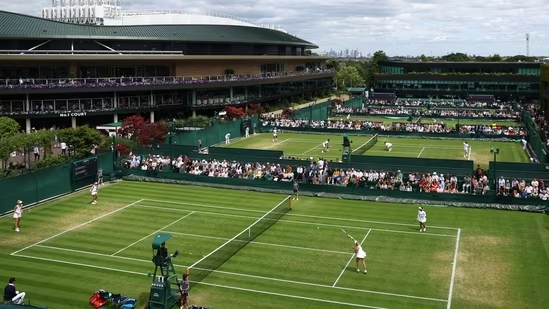Paris to SW19: Big changes in double quick time
Carlos Alcaraz, the US Open champion who cleans up well on the red dirt, brought out his growing feel for the grass during an eye-catching point in his Queen's semi-final. After a chipped forehand return, he took a few little steps to his right for a forehand, then a few little steps to his left for another. As Sebastian Korda put a defensive backhand back in play, Alcaraz took a few little steps inside the baseline and pulled out a forehand winner striking below the waist.  PREMIUM
PREMIUM
Short, quick and precise — the point was as good as the Spaniard’s feet movement. In a sport that romanticises the beauty of the serve, the power from the baseline and the touch at the net, the work of the hands has a strong connect to the flow of the feet. “Tennis is often misunderstood as only a hand game. It's the farthest thing from that," Somdev Devvarman, India’s former world No. 62 pro, says. “Movement cannot be your weakness anymore.”
Especially, on grass. Especially, with Wimbledon on the horizon, the dust from the clay barely having settled. Especially, since the tricky clay-to-grass transition has a lot to do with adjustment in footwork. “A lot changes,” Devvarman says. “Footwork on grass has changed dramatically over the last few years, because people are winning Wimbledon from the baseline now. However, even along the baseline, footwork is vastly different mainly because the ball flies different and the kind of shots you're trying to hit are different.”
There are two key elements to that change going from clay to grass. A. Staying low, because the bounce on the ball is lower and speed greater than the bouncier and heavier clay courts. B. Taking smaller steps to get into positions on court, because the natural green offers lesser grip.
“Staying low is the first thing on grass to feel comfortable in the movement,” Devvarman says. “You have to adjust your body to those different positions, which would be completely opposite to what you would do on clay.”
The same goes for on-court movement, which requires shorter and swifter steps — especially moving laterally — and plenty of footwork drills to adapt from the grinding, sliding and stretching clay swing. “You have to make sure that you take smaller steps to get into positions, that your last step is powerful and, at the same time, you're not overstretching it because that's when you can slip," Devvarman says.
Lack of grip on the surface makes changing direction that much tougher, while there's more diving than sliding on the green. "That is where you have to be precise with your footwork, especially when you're running to a ball wide and then recovering to get back," Devvarman says.
That is also where on-court positioning becomes another key picture of contrast. Because the balls travel a lot quicker, the distance between the player’s feet and the baseline has to be a lot closer. Returning serve standing way back behind the baseline might now be a common sight across clay and hard courts, but would still be a risky proposition on grass.
“You have less time to return a serve; you can't stand way behind and take a massive swing. The ball isn't as heavy, and if it is, the bounce kills it on the grass," Devvarman says. “What might be a great defensive shot on clay would be a horrible shot on grass. And changing that again comes down to a few footwork things: return of serve positions, how to get out of the corners, which balls to go in, how to keep your body position more on the attack when you're moving forward.”
Sliding is a prerequisite for that on clay. Long considered a no-go ploy on grass, modern-day tennis players aren’t averse to carrying that into increasingly slower grass courts. Indeed, Daniil Medvedev has slid and slipped on clay and grass alike. “In some ways, it is an evolution of the game with the grass getting slower and the rallies longer. In some ways, it is also where people are falling short in terms of movement," Devvarman says.
From his own experience, Devvarman “hated playing on grass”, because “for a guy who felt like he could always get that extra ball back on hard or clay courts to steal a point, it was that much harder to do on grass".
What escalates the challenge is the short turnaround between the Grand Slams on clay and grass. Only three weeks separate the French Open and Wimbledon this year. The ATP calendar comprised 11 tournaments on clay starting from April leading into the French Open in May-June. On grass, it has six events, all squeezed together in a three-week window ahead of Wimbledon after which the Tour moves to the hard stuff again. All those modifications in footwork and approach, therefore, have to be done in double quick time.
“Lack of preparation time is the big challenge. Because the grass season is so short, players find it hard to adapt their game just for that six-week window," Devvarman says. “And that is why very few players are specialists on grass in today’s game.”
And that is why this Wimbledon, leaving aside Novak Djokovic, is a wide-open Slam. For, the likes of Swiatek, Aryna Sabalenka, Alcaraz and Medvedev, all in-form Slam champions across hard and clay courts, are still finding their feet—literally and figuratively—on grass.
Enjoy unlimited digital access with HT Premium
Subscribe Now to continue reading Start 14 Days Free Trial Already Subscribed? Sign In
Disclaimer: The copyright of this article belongs to the original author. Reposting this article is solely for the purpose of information dissemination and does not constitute any investment advice. If there is any infringement, please contact us immediately. We will make corrections or deletions as necessary. Thank you.







